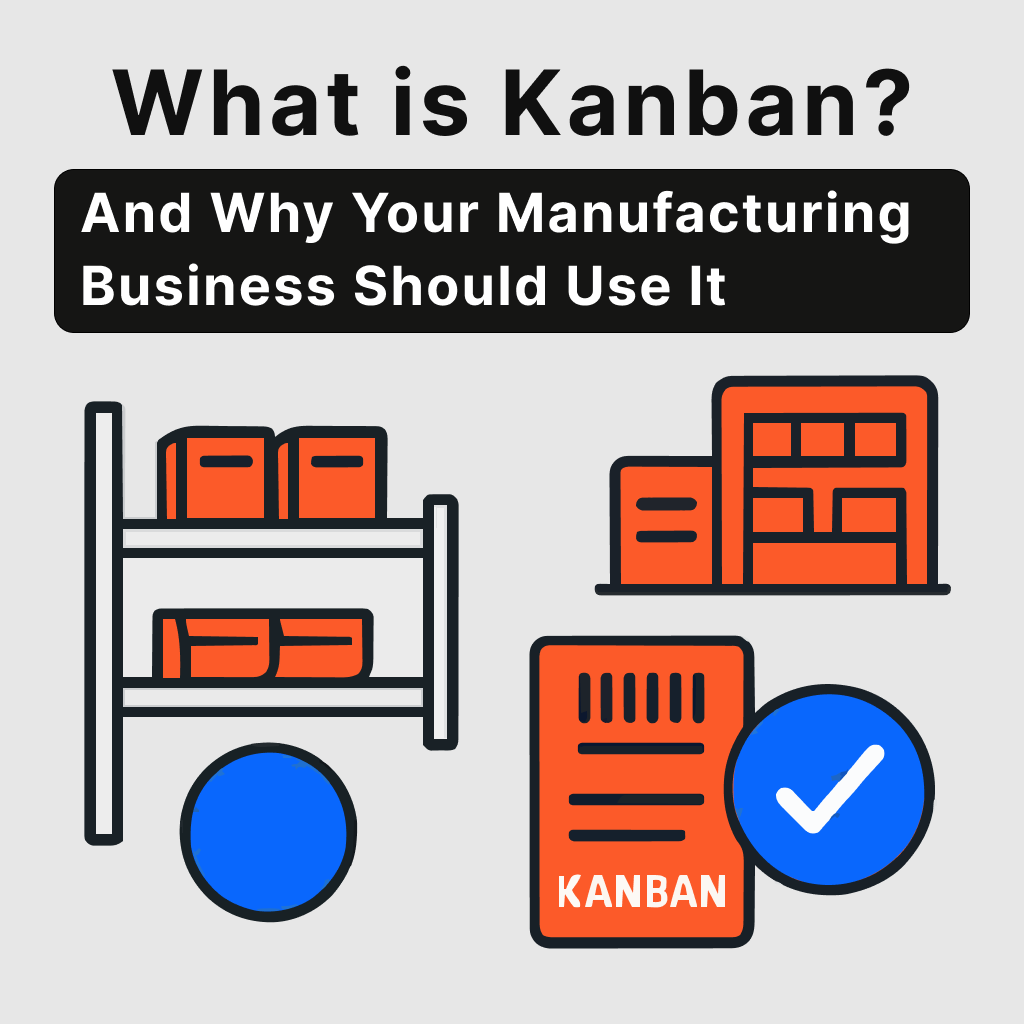If you've ever wondered how top manufacturers maintain optimal inventory levels while responding quickly to varied customer orders and shifting market demands, the answer often lies in a simple yet powerful system called Kanban. Originally developed by Toyota in the 1950s this simple piece of paper is a key tool in the most efficient manufacturing operations on the planet. But how is this simple system made up of Kanban cards able to coordinate the most complex manufacturing processes in the world? The key is a foundational concept called the “Kanban loop.”
At its core a Kanban loop represents the continuous cycle of ordering and replenishing materials in a just-in-time manufacturing environment. This fundamental concept drives efficiency across production floors worldwide, eliminating waste while ensuring materials arrive precisely when needed.
For manufacturers seeking to streamline operations, understanding the mechanics and benefits of implementing a Kanban loop system can be transformative. Let's explore how this elegant solution works and why it might be the missing piece in your production puzzle.
Key Takeaways
- Self-Regulating Inventory System: Kanban and Kanban loops are by design self-regulating systems where actual material consumption triggers replenishment signals, eliminating waste and reducing inventory costs compared to forecast-based ordering systems.
- The system operates on visual signals and pull principles: When workers consume materials from containers, they send Kanban cards or digital signals back to supply points, creating a continuous conversation between production stations.
- Three main types serve different needs: Production Kanban loops connect internal processes, Withdrawal Kanban loops manage movement from storage to production lines, and Supplier Kanban loops extend the system to external vendors.
- Multiple loops can be combined for complex operations: the Two-Card System links withdrawal and production Kanbans to create a chain reaction that synchronizes entire supply chains from raw materials to finished goods.
- Implementation delivers measurable benefits: Reduced waste through elimination of overproduction, enhanced flexibility to respond to market demand shifts and improved quality through smaller batch sizes and faster problem detection.
- Quick and Easy to Set Up: Modern digital systems like Arda can get your first Kanban loop setup and running in just 5 days, making this proven Toyota-developed methodology accessible for manufacturers of any size.
What Exactly Is a Kanban Loop?
A Kanban loop functions as the nervous system of lean manufacturing. It creates a self-regulating flow of materials and information that connects consumption points with supply sources. Unlike traditional inventory management that pushes materials based on forecasts, the Kanban loop operates on a pull principle, where actual consumption triggers replenishment.
The beauty of the Kanban loop system lies in its simplicity and fundamental nature. When a worker consumes materials from a container, they send a signal (traditionally a Kanban card, though modern systems may use digital signals) back to the supply point. This signal initiates the replenishment process, creating a continuous loop of consumption and resupply that maintains optimal inventory levels without excess and with near zero admin work.
Think of it as a conversation between your production stations: "I've used these parts, please send more." This ongoing dialogue ensures nothing is produced or ordered until it's actually needed without complex instrumentation or industry 4.0.
The Mechanics of a Kanban Loop: From Signal to Supply
Understanding how a Kanban loop operates in practice helps clarify why this system is so effective at maintaining optimal inventory levels. Let's examine the journey of a Kanban signal through a complete loop:
- Consumption Trigger: At an electronics assembly plant, when components in a workstation bin drop below the reorder point (perhaps 20% remaining), the operator removes the attached Kanban card.
- Signal Transmission: The operator places this card in a collection box, which is regularly collected and taken to the supply department.
- Production Authorization: The supply department uses this card as authorization to produce or order the exact quantity specified on the card.
- Replenishment: Once the new components are ready, they're delivered to the original workstation along with the Kanban card, which is reattached to the bin.
- Loop Completion: The cycle is now complete and ready to begin again when consumption reaches the trigger point.
What distinguishes a Kanban loop from other inventory systems is this continuous cycle of consumption-based replenishment. Nothing moves without a signal, and the signal is generated only by actual use, not by forecasts or assumptions.
The Anatomy of an Effective Kanban Loop
A successful Kanban loop relies on several key components working in harmony. Understanding each element helps manufacturers design systems that maintain optimal production flow:
Visual Signals
The foundation of any Kanban loop implementation is its visual nature. These signals might be traditional cards, empty containers, colored magnets, or digital indicators on a dashboard. At Toyota's manufacturing plants, where Kanban originated, color-coded cards provide instant visual cues about material status, with red cards indicating urgent replenishment needs and yellow showing standard orders.
The visual aspect ensures transparency across the production process. Everyone from operators to managers can see at a glance what needs replenishing and when, creating a shared understanding of current production status.
Consumption Points
These are the workstations or areas where materials are used in production. In an effective Kanban loop, the consumption point is clearly defined with marked locations for materials and visual indicators for reorder points. For example, a furniture manufacturer might designate specific zones on the assembly floor where hardware components are stored, with clearly marked minimum quantity lines that trigger reordering when exposed.
Supply Points
Supply points can be internal production areas, warehouses, or external suppliers who respond to Kanban signals. These points must be organized to respond quickly to signals, with clear processes for receiving Kanbans and prioritizing production or delivery. A well-designed supply point includes dedicated areas for incoming Kanban signals and outgoing materials, with visual management tools to track response times.
Transportation Mechanisms
The methods by which materials and signals move between consumption and supply points form critical connections in the loop. These might include dedicated material handlers, automated guided vehicles, or regular delivery routes. The key is reliability and consistency, ensuring signals and materials move predictably through the system.
Rules and Policies
Clear guidelines govern how the Kanban loop operates, including who responds to signals, how quickly, and what happens when issues arise. These rules might specify that all Kanban signals must be processed within two hours, or that emergency signals receive priority handling. Well-documented policies ensure everyone understands their role in maintaining the flow of the Kanban loop.
When these elements work together, the Kanban loop creates a rhythm in production that's responsive to actual needs rather than projections or guesswork, resulting in smoother operations and reduced waste.
Why Manufacturers Embrace the Kanban Loop Approach
The adoption of Kanban continues to grow across manufacturing sectors, and for good reason. The benefits of Kanban extend far beyond simple inventory control:
- Reduced Waste: By producing only what's needed when it's needed, Kanban loops dramatically reduce overproduction, which is considered the most serious form of waste in lean manufacturing. Storage costs decrease, and the risk of obsolete inventory virtually disappears.
- Reduced Downtime: By ensuring continuous replenishment of materials tied to actual consumption patterns Kanban can completely eliminate stockouts and prevent downtime in your production facilities.
- Enhanced Flexibility: When market demands shift, a well-designed Kanban loop allows production to adjust naturally. There's no massive inventory of unwanted products to clear before responding to new customer preferences.
- Improved Quality: With smaller batch sizes and more frequent production cycles, quality issues are identified and resolved more quickly. The continuous flow of the Kanban loop system means problems affect fewer products before detection.
- Greater Visibility: The visual nature of Kanban loop management creates transparency across the production process. Bottlenecks become immediately apparent, allowing for quick intervention.
- Empowered Teams: Workers in a Kanban loop environment gain autonomy to manage their own material needs. This responsibility often leads to increased engagement and continuous improvement suggestions.
For manufacturers facing volatile markets and increasing customer expectations for customization, implementing Kanban loops provides the agility needed to remain competitive without the massive undertaking of an ERP implementation.
%201.svg)








.svg)














.svg)
.svg)

.svg)